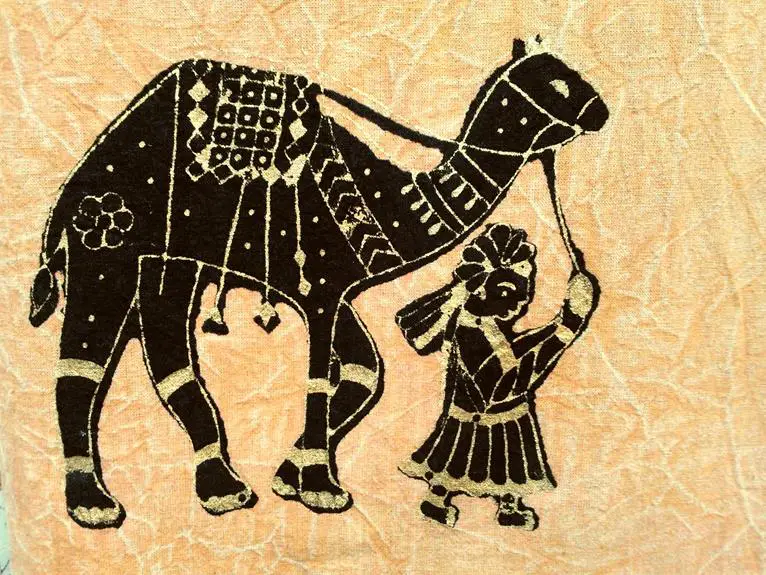You may not realize it, but behind many of the stunning fabric designs you admire lies the secret of rotary printing. This innovative and intricate process has been the cornerstone of creating intricate and vibrant patterns on fabrics for decades.
In this brief exploration, you'll uncover the history, process, advantages, and future of rotary printing, gaining a deeper understanding of how this technique has revolutionized the world of fashion and home decor.
So, prepare to delve into the fascinating world of rotary printing and discover the hidden artistry that adorns the fabrics you love.
Key Takeaways
- Rotary printing revolutionized the textile industry by allowing for the production of vibrant and detailed patterns at a faster pace.
- It offers cost efficiency in terms of labor, time, and material expenses, making it the preferred choice for textile manufacturers aiming for efficiency and quality.
- Rotary printing utilizes cylindrical screens to apply designs onto fabric, ensuring consistent and accurate reproduction of intricate patterns with fine details.
- The advancements in rotary printing, such as eco-friendly inks, energy-efficient processes, and digital fabric printing, contribute to a greener future and improved design quality.
The History of Rotary Printing
Exploring the history of rotary printing reveals its significant impact on fabric design and production. The evolution of technology has played a pivotal role in shaping the way fabrics are designed and produced.
Rotary printing, with its ability to mass-produce intricate designs, has revolutionized the textile industry, making it possible to create stunning patterns with unparalleled precision and speed. This technological advancement hasn't only transformed the way fabrics are manufactured but has also had a profound impact on global trade.
The introduction of rotary printing in the 18th century marked a turning point in fabric production. The ability to produce vibrant, detailed patterns at a much faster pace than traditional methods greatly influenced the global textile market. As a result, the demand for intricately designed fabrics soared, leading to an expansion of trade networks and the globalization of textile commerce.
The history of rotary printing serves as a testament to the power of technological innovation in shaping the fabric industry and its impact on global trade. This evolution has paved the way for a diverse and interconnected global market for fabric designs, showcasing the enduring significance of rotary printing in the textile world.
The Rotary Printing Process
The rotary printing process utilizes cylindrical screens to apply colorful and intricate designs onto fabric, allowing for efficient mass production with unparalleled precision and speed. As the fabric moves through the rotary printing machine, each cylindrical screen applies a different color, layering to create the final design. This mechanical precision ensures that the intricate patterns are reproduced consistently and accurately across the fabric, resulting in stunning and high-quality designs.
The cylindrical screens are engraved with the specific design elements, and as they rotate, they continuously apply the dye onto the fabric in a seamless and precise manner. This process allows for the creation of intricate patterns with fine details, making rotary printing particularly suitable for fabrics with elaborate designs and multiple colors.
Additionally, the speed at which the rotary printing process operates enables large volumes of fabric to be printed in a relatively short amount of time, making it a highly efficient method for mass production. The combination of speed, precision, and the ability to produce complex designs makes rotary printing a preferred choice for textile manufacturers aiming to create stunning fabric designs at scale.
Advantages of Rotary Printing
With its efficient mass production capabilities and precise replication of intricate designs, rotary printing offers textile manufacturers a competitive edge in creating stunning fabric designs at scale.
The advantages of rotary printing are numerous, making it an indispensable technique for textile production. Here's why rotary printing stands out:
- Cost Efficiency: Rotary printing is incredibly cost-efficient, as it allows for high-speed, continuous production, reducing labor and time costs significantly. The process also minimizes ink wastage, resulting in lower material expenses.
- Large Scale Production: One of the most significant advantages of rotary printing is its ability to cater to large-scale production demands. The seamless and rapid printing process enables manufacturers to fulfill orders in a timely manner without compromising on quality.
- Versatile Design Replication: Rotary printing excels in replicating intricate and complex designs with exceptional accuracy, ensuring that every piece of fabric maintains the intended pattern and color scheme.
These advantages make rotary printing a favored method for textile manufacturers looking to maximize efficiency and quality while meeting the demands of large-scale production.
Rotary Printing in Fashion
You can incorporate rotary printing into your fashion designs to achieve vibrant and intricate fabric patterns with precision and efficiency. As fashion trends evolve, designers are constantly seeking innovative printing techniques to elevate their creations. Rotary printing offers a seamless way to produce high-quality fabrics with remarkable design impact.
The technique ensures that the intricate details and vibrant colors of your designs are accurately transferred onto the fabric, enhancing the overall quality of your creations.
When it comes to fabric quality, rotary printing excels in maintaining the integrity of the material, ensuring that the colors stay rich and the fabric remains soft to the touch. This is essential for creating garments that not only look stunning but also feel comfortable to wear.
Additionally, the efficiency of rotary printing allows for the quick production of fabric, enabling you to keep up with the fast-paced nature of the fashion industry.
Incorporating rotary printing into your fashion designs enables you to stay ahead of the curve, producing fabrics that align with the latest fashion trends while maintaining a high standard of quality and design intricacy.
Rotary Printing in Home Decor
Create captivating home decor with rotary printing, infusing your living spaces with vibrant and intricate fabric designs. Rotary printing offers a myriad of benefits for home decor enthusiasts like you:
- Custom Patterns: With rotary printing, you can bring your unique design ideas to life. Whether it's a specific color palette or a one-of-a-kind pattern, rotary printing allows for customization, ensuring that your home decor reflects your personal style and vision.
- Fabric Durability: When it comes to home decor, durability is key. Rotary printing ensures that your fabric designs maintain their vibrancy and quality over time. The precision of rotary printing also results in long-lasting patterns that won't fade or wear easily, making it an ideal choice for upholstered furniture, curtains, and decorative pillows.
- Versatile Applications: Rotary printing isn't limited to just one type of fabric or home decor item. Its versatility allows for the creation of stunning designs on a wide range of materials, including cotton, linen, and silk, offering endless possibilities for transforming your living spaces.
Incorporating rotary printing into your home decor endeavors will undoubtedly elevate the aesthetic appeal and longevity of your fabric designs.
Innovations in Rotary Printing
Innovations in rotary printing have expanded the possibilities for creating custom patterns and durable fabric designs for home decor, offering even more versatility in transforming your living spaces. Ink technology has been a game-changer, allowing for a wider range of colors and special effects to be achieved, resulting in more vibrant and detailed designs. The precision of design has also seen significant improvements, with advanced software and machinery enabling intricate and complex patterns to be printed with exceptional accuracy.
The introduction of eco-friendly and sustainable inks has been a notable innovation in rotary printing. These inks not only offer brilliant color reproduction but also align with the growing demand for environmentally conscious practices in the textile industry. Additionally, the development of high-speed rotary printing machines has increased efficiency and productivity, making it possible to produce larger quantities of fabric without compromising on quality.
Furthermore, advancements in digital printing technologies have allowed for greater customization and personalization, empowering designers to bring their unique visions to life with unparalleled detail and clarity. These innovations have undoubtedly revolutionized the world of rotary printing, opening up new creative possibilities and setting the stage for even more remarkable fabric designs in the future.
Sustainability in Rotary Printing
Utilize sustainable practices in rotary printing to reduce environmental impact and meet the growing demand for eco-friendly fabric designs. When it comes to sustainability in rotary printing, there are several crucial factors to consider:
- Eco-friendly Inks: Opt for water-based or vegetable-based inks that are free from harmful chemicals, reducing the environmental impact without compromising on vibrant color and durability.
- Energy-Efficient Processes: Implement energy-saving technologies and processes to minimize electricity consumption, contributing to a more sustainable production cycle.
- Recycling and Waste Reduction: Embrace recycling initiatives and waste reduction strategies to minimize the environmental footprint of rotary printing, ensuring that resources are used efficiently and responsibly.
By integrating these sustainable practices into rotary printing, you not only contribute to a healthier environment but also cater to the increasing market demand for environmentally conscious fabric designs.
Embracing sustainability in rotary printing isn't just a trend but a necessary step towards a more eco-friendly and responsible approach to fabric design and production, ensuring a greener future for the industry.
Future of Rotary Printing
As you consider the future of rotary printing, it's important to recognize how sustainability practices will continue to play a pivotal role in shaping the industry. However, there are other significant factors that will also influence the future of rotary printing.
Technological advancements are set to revolutionize the industry, offering more efficient and environmentally friendly printing processes. Innovations such as digital fabric printing and advanced automation systems will streamline production, reduce waste, and offer greater design flexibility. These advancements won't only enhance productivity but also contribute to sustainable practices.
Market trends also hold considerable sway over the future of rotary printing. As consumer demand for personalized and uniquely designed fabrics continues to surge, rotary printing will need to adapt to meet these evolving preferences. This may involve the integration of customization technologies and the ability to quickly respond to changing design trends. Additionally, the demand for sustainable and eco-friendly products is expected to shape the market, prompting rotary printers to embrace eco-conscious practices and materials.
Frequently Asked Questions
Can Rotary Printing Be Used on Materials Other Than Fabric, Such as Paper or Plastic?
Yes, rotary printing can be used on materials other than fabric. The process offers versatile applications, making it suitable for paper and plastic. Its precision and efficiency make it a viable option for various materials.
How Does Rotary Printing Compare to Other Printing Methods in Terms of Cost and Efficiency?
When comparing printing methods, rotary printing offers cost advantages due to its high production speed and efficient ink usage. Efficiency analysis shows that it can produce large quantities at a lower cost compared to other printing methods.
Are There Any Limitations to the Types of Designs That Can Be Achieved Through Rotary Printing?
When considering rotary printing, you'll find limitations in design complexity and color vibrancy. However, the creative possibilities are vast, allowing for intricate patterns and vivid hues. Understanding these factors ensures optimal results for fabric designs.
What Are the Environmental Impacts of the Chemicals and Dyes Used in Rotary Printing, and Are There Any Efforts to Minimize These Impacts?
To minimize environmental impacts, efforts focus on researching chemical alternatives and implementing eco-friendly dyes. Innovations strive to reduce water and energy usage, aiming for sustainable practices in rotary printing. These endeavors aim to mitigate the ecological footprint.
How Has Technology Advanced the Capabilities of Rotary Printing in Recent Years, and What New Possibilities Does This Open up for Designers and Manufacturers?
Advancements in rotary printing have been remarkable. Digital integration has revolutionized the process, offering innovative applications and creative possibilities for designers and manufacturers. This has opened up new realms of design and production.
- Does Chiffon Fabric Stink - July 15, 2025
- Does Chiffon Fabric Affect the Economy - July 15, 2025
- Does Cotton Fabric Have a Nap - July 15, 2025



